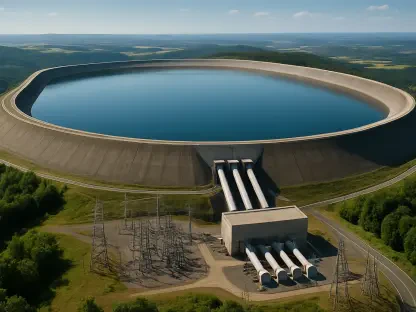In a world increasingly strained by environmental challenges, the innovative approach undertaken by the Gila River Indian Community (GRIC) stands out as a groundbreaking solution. Combining renewable energy generation with water conservation, GRIC’s experiment involves the novel placement of solar panels over canal waters to shade and thus minimize evaporation. This initiative poses a timely and critical response to the persistent droughts afflicting the Colorado River Basin, representing a potential game-changer in the intersecting fields of energy and water management.
Introduction
The Colorado River Basin, a vital water source for nearly 40 million people across multiple states, tribes, and parts of Mexico, faces a severe water scarcity crisis. The river frequently endures demand that surpasses its supply, heightened by prolonged droughts linked to climatic changes. This environmental stress has exacerbated the depletion levels in key reservoirs like Lake Powell and Lake Mead. Within this context, GRIC’s initiative provides not only immediate relief but also opens pathways for long-term solutions by integrating solar panels over water bodies. The endeavor not only aims to generate sustainable electricity but also seeks to significantly reduce water loss through evaporation, both essential in arid communities.
Methodology, Findings, and Implications
Methodology
The GRIC project has established solar panel arrays strategically positioned atop canal systems—an unprecedented setup within the United States. This methodology focuses on harnessing solar technology to deliver a dual benefit: sustainable energy production and water conservation by reducing evaporation rates through shading. Additionally, plans are underway to extend solar coverage over a newly developed reservoir. Comprehensive data collection involves monitoring energy outputs and evaporation rates, alongside analyzing the economic viability and environmental impacts of the installation.
Findings
The results from GRIC’s canals clearly demonstrate the solar panels’ efficiency in energy production while showing promise in evaporation reduction—a vital factor in water preservation efforts. The cooling effect of water has been observed to improve the operational efficiency of solar panels. Yet, challenges linked to installation costs and potential effects on aquatic ecosystems remain. Despite these hurdles, deploying solar panels on water bodies presents an intriguing potential to supplement hydropower and lessen traditional dam usage that relies heavily on water consumption for power generation.
Implications
The implications of GRIC’s initiative underscore its relevance as a model for sustainable resource management. The ecological benefits associated with reduced evaporation contribute to broader conservation efforts within arid Western states. Moreover, the integration of solar technology represents a forward-thinking approach that increases the renewable energy output while reducing dependence on non-renewable power sources. On a societal front, this initiative can inspire policy shifts and galvanize stakeholders across the Colorado Basin toward collective adoption of such technologies.
Reflection and Future Directions
Reflection
Reflecting upon the project, several barriers came into focus such as higher costs associated with floating solar arrays compared to land-based installations, alongside concerns about their impact on local ecosystems and recreational activities. Despite these challenges, the positive reception within the community and support through funding initiatives showcase the promise and feasibility of the effort. GRIC’s administration has adapted remarkably in navigating complexities linked to political and economic factors surrounding renewable energy deployment, setting a benchmark in adaptive local governance.
Future Directions
Looking ahead, there exists considerable potential for expansion in solar panel deployment over bodies of water within the Colorado River Basin and beyond. Future research can delve into optimizing panel angles for maximum efficiency, designing cost-effective buoy systems, and assessing long-term ecological impacts on aquatic life. Addressing unanswered questions around technological impacts on greenhouse gas emissions and water quality remains vital. Such advancements will likely facilitate broader acceptance and implementation across regions facing similar constraints.
Conclusion and Final Perspectives
The GRIC’s pioneering initiative to harness solar energy for dual purposes of power generation and water conservation marks a significant milestone in sustainable environmental management. The study’s findings offer pivotal insights into reducing evaporation losses in arid climates, laying groundwork for future exploration of solar water management frameworks. These efforts prove especially crucial in the face of intensifying drought conditions within the Colorado River Basin and potentially beyond, opening doors for adaptable strategies in renewable energy development and water conservation. Moving forward, investing in innovative technology designed to mitigate environmental challenges reflects the necessary evolution in resource management approaches for ensuring ecological resilience and sustainability.









